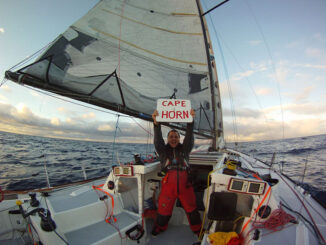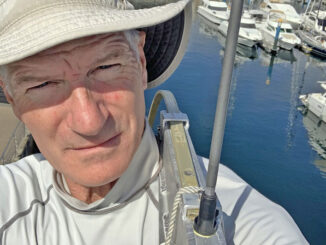
United Kingdom – 6/2/2021 – By Marco Nannini – Seasickness is caused by the interaction between the organs of balance, the visual and tactile systems and the brain. While being thrown around a boat, our brain cannot reconcile the messages it receives. It is over-stimulated by conflicting information caused by the continuous acceleration and deceleration.
The result is that the brain comes to the conclusion that you have been poisoned! It therefore induces the body to vomit to get rid of the harmful substances that it imagines have been ingested. It is therefore an instinctive survival reflex, unfortunately useless, because obviously vomiting does not solve the situation in any way.
No one is totally immune, but surely some suffer seasickness more than others. Especially different people react totally differently which is a significant risk factor when sailing with short-handed.
How to avoid it
Avoiding seasickness is possible within certain limits and certainly there are many aspects that can improve or worsen the situation. I’m not talking about what to eat for breakfast or what to do in preparation for a Sunday trip. There are tons of resources that offer diet advice and grandma’s remedies. To avoid seasickness you must first understand the causes and act on them.
Only a methodical approach of the skipper and meticulous preparation guarantees the safety of all. When the weather gets bad we are used to seeing stressful scenes, people screaming, and a lot of confusion. A trained skipper prevents and never faces these unnecessary additional problems.
Medicines
There are medicines that work by reducing the sensitivity of the organs of balance. Therefore, with the same movement, the messages sent by this organ to the brain are attenuated. Medicines work but usually those who should take them forget to do it in time, making them less effective.
They also cause drowsiness and often you find yourself with zombies on board totally dazed. Half asleep, they will be unable to stay awake when it is their turn to be on watch, a real problem if you are short-handed. Medicines are therefore not the panacea but they can certainly alleviate symptoms.
Consult your pharmacist for over the counter medicines available in your country.
Reducing confusion of the senses
The root of seasickness lies in the brain’s inability to interpret signals received from various organs. Any action that reduces this confusion will help both avoid and reduce the feeling of seasickness.
If you are in the cockpit the eye will see the waves and the movement of the boat. You will therefore find a partial explanation of what the organs of balance are communicating. It is no coincidence that helming is an excellent remedy, focusing on the route and on the boat. In this way all the movement begins to make much more sense and the brain reduces the attempt to react to the alleged poisoning.
When standing, there are no constant pressure points on the body like when we are sitting, hence when standing there is one less source of signals to interpret. The passage of time and experience also matter, because the brain will gradually get used to the abnormal situation considering it more and more normal.
If we turn off one of the communication channels to the brain, the situation will improve. If you are below deck the eyes are a source of worrying images, the interior of the boat does not move. However, we are thrown around inside the boat, so looking around makes the situation worse, under deck it is better to stay with your eyes closed.
The brain will only have to decipher the messages of the organ of balance and the pressure on the surface of the body. It is no coincidence that by lying down the situation improves further, with the whole body stretched out. Uniform pressure is less interesting for the brain to analyse.
If we choose a position as central and as low as possible, the movement will be reduced and the organ of balance less stimulated. Even during my trip around the world we even slept on the floorboards, amidships near the keel. First because from there you could not fall any further and risk getting hurt. Secondly, it was possible to sleep better for the lesser movement even in extreme conditions.
So, thinking about the various factors at play, being at the helm or in a berth are undoubtedly the two best places. If you sail with a small crew you can just go between these two locations without wasting time. Either awake at the helm or lie down to sleep.

Secondary factors
In addition to the obvious motion stimuli described so far there are important secondary factors for the whole crew. While they are not the cause of seasickness by themselves, they certainly contribute to worsening the situation. First of all the feeling of cold, but also tiredness and stress. Some suffer from smells like diesel, but don’t underestimate fear and even the fear of being seasick.
Temperature control
Seasickness usually occurs and worsens with increasing wind and sea conditions. Under these conditions, due to the windchill, the perceived temperature begins to drop. The crew members crowded into the cockpit risk getting cold as they go. Unfortunately, being cold also contributes to the development of seasickness. If you are a skipper, you must therefore make sure that everyone is well dressed. If the sky gets dark and the wind picks up, ask each crew member to get dressed.
Even better, bring them clothes from below deck, you will see that they will not hesitate to wear them. One of the characteristics of seasickness is that it leads to laziness and apathy in those who suffer from it. The affected person cannot think of simple gestures that would help him improve the situation. Like trivially getting to wear a fleece under the oilskin, a windbreaker or a hat.
If you are heavily dressed, however, be careful when you go below deck. The sudden change in temperature could give you an immediate sense of nausea. So, before going below, open your jacket and fleece if it has a zip. Then go down and without hesitation lie down and close your eyes. As the body readjusts to the new temperature, you can possibly close the fleece or cover yourself with a blanket. It all depends on the season of course and the place of navigation.

How to understand who’s about to feel seasick
As a skipper you must give yourself the absolute priority to understand who is suffering or could suffer from seasickness. Rule number one is to continuously evaluate the responsiveness of each crew member. Those who are talking and continue talking are fine, but the talkers will become very quiet at the first hint of seasickness.
So always ask the silent ones how they are, if they answer you hastily “well well” it means that they already have seasickness. Usually everyone is ashamed to admit it and will pretend otherwise until the end. They will tell you that they have and upset stomach or that they haven’t digested their sandwich at lunch! In short, they are just seasick and they’d better let the skipper know immediately so that he can adjust accordingly.
Clip on and wear your life-jacket
Seasick people in the cockpit could get up suddenly and launch themselves towards the rail to vomit and fall into the water in the process. So be firm and firm on the subject, anyone unable to steer or maintain a conversation has reached a critical level. The sooner this person lies down, the fewer the potential consequences to handle.
I would also add that, for those who are still in the cockpit, if the sea and wind increase, it is time to clip on. The image of someone who suffers from seasickness suddenly launching themselves to leeward is one we have all seen.

Prepare the boat
As the situation worsens you may find yourself with more than one crew member down. It is therefore important to prepare the boat before any trip in which difficult conditions can be expected.
Take it for granted that someone will get seasick by preparing the lee cloths for the bunks and put buckets close at hand. Every situation becomes an emergency due to a lack of preparation and prevention. An experienced skipper will not be surprised and anticipating every move will keep the situation under control.
Diesel
The smell of diesel bothers many even if it is simply an accelerator of the phenomenon. If there is a smell of diesel fuel below decks, some could hardly tolerate it. But if their seasickness is important, still force them to lie down and close their eyes rather than keep them in the cockpit.
I remember the start of the leg from Shetland to Lerwick during the Round Britain and Ireland 2010. A retaining o-ring on a tank tube had failed. We ended up with about thirty litres of diesel sloshing in the bilges. The boat didn’t even have floorboards and with the diesel it was as slippery as an ice rink. Outside there were already 45 knots of wind and a force 10 storm was expected with freezing north winds.
The impassive organizers made us leave for the next leg as if it were any day. I spent hours below deck totally covered in diesel, drying it with a sponge. Then with dish soap, I had to degrease repeatedly. A hellish job that I do not wish to anyone, fortunately, I was then sure, I do not suffer from seasickness at all.

Tiredness
Fatigue is an important secondary factor, especially in long voyages. Often it is the less experienced ones who are terrified of going below deck and insist on staying in the cockpit.
Eventually exhausted and cold, they capitulate and begin to feel sick. Instead, it is better to alternate time in the cockpit with short rests while lying down. If you do not waste time below deck but immediately jump into your berth and close your eyes, you could get up again after about ten minutes completely recovered.
Stress and fear
Stress acts in a similar way to fatigue and is simply a contributing factor to the situation. The skipper will have to do his best to remain calm and smiling and reassure everyone. Acting with clear actions and keeping the situation under control.
At his first hesitation there will inevitably be the first defections among the less experienced who will feel in danger. The worried novices will become silent and it will only be a matter of time before they find themselves with a problem to handle. Cold, tired people, no one willing to go below deck and apathetic at every command.
What to do if someone is seasick
Send them and keep them below deck lying down with a bucket available, never let them overstay in the cockpit in those conditions even if they protest. When you suffer from very violent seasickness you would rather die but you will be disappointed to find that there will be no quick solution to the torture, you will live. Only if a person suffers from seasickness for several consecutive days will you have a real worry on your hands.
First make sure that they drink and if possible that they integrate the lost mineral salts. Where possible make them eat a little something to recover their energy. But if you left port in the morning and you have to return in the evening, the only real concern is that they may fall into overboard. Or, that they get hurt as they drag themselves like zombies from one side of the cockpit to the other.
Returning to port
The best way to make your crew feel better is to take cover and return to port. If you are not racing or sailing towards a specific destination, you might as well return to port. Anyway, when your crew is sick, they will certainly not have fun. Likewise, a little seasickness doesn’t kill anyone. If a crew member suffers from it while there are enough arms left to continue sailing, send the unfortunate one to sleep, it’s part of life at sea.
Boat handling
If you are not racing and if your course can be changed, the intelligent skipper will choose a more comfortable course for the boat. Especially if he finds himself with a group of pale people at the first gust of wind. He will cracks the sails, bear away and maybe point in the direction of an alternative port instead of insisting on an uncomfortable upwind beat.
Conclusions
No one is completely immune to seasickness but surely some suffer more than others. If you get seasick, you need to be patient and try to relax as much as possible. Contrary to what most people imagine, the best place to stay is to lie down in the bunk where you will probably fall asleep.


